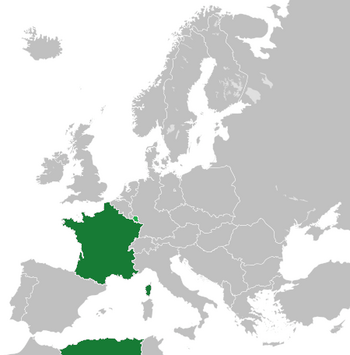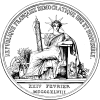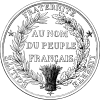French Fourth Republic facts for kids
Quick facts for kids
French Republic
République française (French)
|
|||||||||||
|---|---|---|---|---|---|---|---|---|---|---|---|
| 1946–1958 | |||||||||||
|
National emblem
(unofficial) |
|||||||||||
|
Anthem: "La Marseillaise"
|
|||||||||||

|
|||||||||||
| Capital and largest city
|
Paris 48°51′N 2°21′E / 48.850°N 2.350°E |
||||||||||
| Official language | French | ||||||||||
| Religion | Secular state
In Alsace-Moselle |
||||||||||
| Demonym(s) | French | ||||||||||
| Government | Unitary parliamentary republic | ||||||||||
| President | |||||||||||
|
• 1947–1954
|
Vincent Auriol | ||||||||||
|
• 1954–1959
|
René Coty | ||||||||||
| Prime Minister | |||||||||||
|
• 1947 (first)
|
Paul Ramadier | ||||||||||
|
• 1958–1959 (last)
|
Charles de Gaulle | ||||||||||
| Legislature | Parliament | ||||||||||
| Council of the Republic | |||||||||||
| National Assembly | |||||||||||
| Historical era | |||||||||||
|
• Constitutional referendum
|
13 October 1946 | ||||||||||
|
• Fourth Republic
|
27 October 1946 | ||||||||||
| 13 March 1954 | |||||||||||
|
• Toussaint Rouge
|
1 November 1954 | ||||||||||
|
• Treaty of Brussels
|
17 March 1948 | ||||||||||
|
• May crisis
|
13 May 1958 | ||||||||||
|
• Constitutional referendum
|
28 September 1958 | ||||||||||
| 4 October 1958 | |||||||||||
| Area | |||||||||||
| 1957 | 889,898 km2 (343,592 sq mi) | ||||||||||
| Currency |
|
||||||||||
| ISO 3166 code | FR | ||||||||||
|
|||||||||||
| Today part of | |||||||||||
The French Fourth Republic was the government of France from 1946 to 1958. It was a republic, meaning the people elected their leaders, not a king or queen. This government was set up after World War II.
It was similar to the French Third Republic, which ruled France before the war. Both governments faced some of the same challenges.
Contents
What Was the Fourth Republic?
The Fourth Republic was a period when France tried to rebuild after World War II. It was a time of big changes for the country. The government was based on a new set of rules called a constitution.
How the Government Worked
The Fourth Republic was a parliamentary republic. This means that the Parliament had a lot of power. The Parliament was made of two parts:
- The National Assembly
- The Council of the Republic
The government also had a President and a Prime Minister. The President was the head of state, like a symbol of the country. The Prime Minister was the head of government, who managed the country's daily business.
Leaders of the Fourth Republic
During this time, France had two Presidents:
- Vincent Auriol (1947–1954)
- René Coty (1954–1959)
Many different Prime Ministers led the government. The first was Paul Ramadier in 1947. The last was Charles de Gaulle from 1958 to 1959.
Challenges Faced by France
The Fourth Republic faced many difficult problems. These included rebuilding the country after the war. It also had to deal with its colonies around the world.
Decolonization
Many countries that were once colonies of France wanted to become independent. This process is called decolonization. It led to conflicts and wars.
Wars for Independence
One major conflict was the Battle of Dien Bien Phu in 1954. This battle was part of a war in Vietnam, which was then a French colony. France lost this battle, and it led to Vietnam's independence.
Another important event was the start of the Algerian War. This began with an uprising called Toussaint Rouge on November 1, 1954. This war was very difficult for France and lasted for many years.
Political Instability
The government of the Fourth Republic was often unstable. Prime Ministers changed very often. This made it hard for the government to make long-term plans and solve big problems.
The End of the Fourth Republic
The problems, especially the war in Algeria, led to a major crisis in May 1958. Many people felt that the government was not strong enough.
Creating a New Government
To fix the problems, a new constitution was written. The people of France voted on this new constitution in September 1958. They approved it.
This new constitution created the French Fifth Republic. This new government started on October 4, 1958. It gave more power to the President. Charles de Gaulle became the first President of the Fifth Republic.
See also
 In Spanish: Cuarta República francesa para niños
In Spanish: Cuarta República francesa para niños





